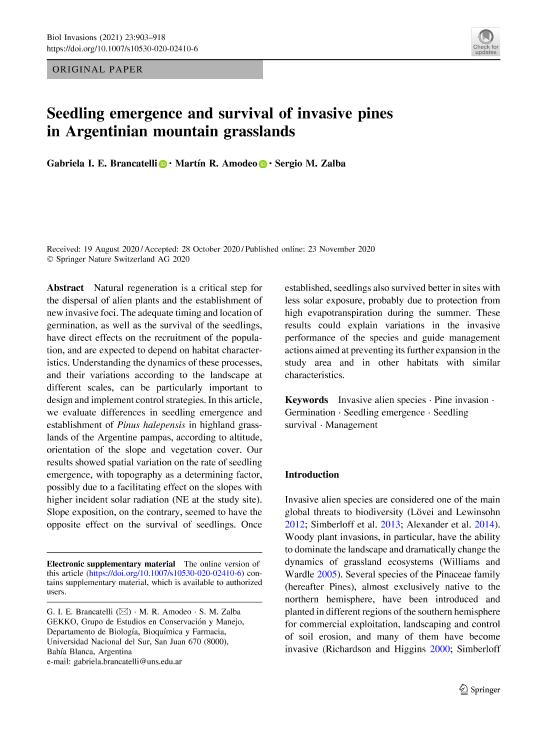Artículo
Seedling emergence and survival of invasive pines in Argentinian mountain grasslands
Fecha de publicación:
28/10/2020
Editorial:
Springer
Revista:
Biological Invasions
ISSN:
1387-3547
Idioma:
Inglés
Tipo de recurso:
Artículo publicado
Clasificación temática:
Resumen
Natural regeneration is a critical step for the dispersal of alien plants and the establishment of new invasive foci. The adequate timing and location of germination, as well as the survival of the seedlings, have direct effects on the recruitment of the population, and are expected to depend on habitat characteristics. Understanding the dynamics of these processes, and their variations according to the landscape at different scales, can be particularly important to design and implement control strategies. In this article, we evaluate differences in seedling emergence and establishment of Pinus halepensis in highland grasslands of the Argentine pampas, according to altitude, orientation of the slope and vegetation cover. Our results showed spatial variation on the rate of seedling emergence, with topography as a determining factor, possibly due to a facilitating effect on the slopes with higher incident solar radiation (NE at the study site). Slope exposition, on the contrary, seemed to have the opposite effect on the survival of seedlings. Once established, seedlings also survived better in sites with less solar exposure, probably due to protection from high evapotranspiration during the summer. These results could explain variations in the invasive performance of the species and guide management actions aimed at preventing its further expansion in the study area and in other habitats with similar characteristics.
Archivos asociados
Licencia
Identificadores
Colecciones
Articulos(IADO)
Articulos de INST.ARG.DE OCEANOGRAFIA (I)
Articulos de INST.ARG.DE OCEANOGRAFIA (I)
Citación
Brancatelli, Gabriela Ivanna Elizabeth; Amodeo, Martín Raúl; Zalba, Sergio Martín; Seedling emergence and survival of invasive pines in Argentinian mountain grasslands; Springer; Biological Invasions; 23; 3; 28-10-2020; 903-918
Compartir
Altmétricas




